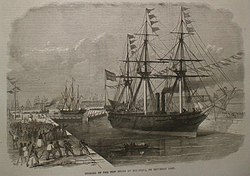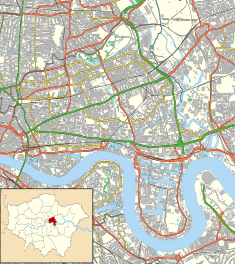Historic site in London
| Millwall Dock | |
|---|---|
 Opening of new docks at Millwall in 1868 Opening of new docks at Millwall in 1868 | |
| Location | London |
| Coordinates | 51°29′43.37″N 0°0′58″W / 51.4953806°N 0.01611°W / 51.4953806; -0.01611 |
| Built | 1802 |
| Built for | Built speculatively by John Kelk and John Aird & Co. |
| Architect | Sir John Fowler |
 | |
Millwall Dock is a dock at Millwall, London, England, located south of Canary Wharf on the Isle of Dogs.
History



The scheme was developed speculatively by a partnership of John Kelk and John Aird & Co. The engineer responsible for designing the scheme was Sir John Fowler. The construction was undertaken by Kelk and Aird and the dock was officially opened in March 1868. After a slow start to the business and financial difficulties, Kelk and Aird surrendered control of the company to lawyers acting for the investors in December 1868. In recognition of its settled status the business was renamed the Millwall Dock Company in 1870.
From 1897 to 1921, it was served by the Millwall Docks railway station on the Millwall Extension Railway, with goods services continuing to the 1970s.
In 1909 the Port of London Authority (PLA) took over the Millwall Dock, along with the other enclosed docks from St Katharines to Tilbury.
From 1905 Magnus Mowat worked as Engineer to the docks, being promoted to Director around 1912.
With reorganisation by the Port of London Authority in the 1920s, the northern end of the Inner Dock was connected to the West India Docks by the Millwall Passage.
The dock was used mainly for timber and grain, a trade which eventually moved down river to the Port of Tilbury with the construction of a major grain terminal in the 1960s. A McDougall's flour mill, the Wheatsheaf Mill (constructed in 1869), stood on the south side of the Outer Dock, but was demolished in about 1980. Nearby Sir John McDougall Gardens is named after one of the McDougall brothers, John McDougall, who was also a prominent local politician in Poplar.
From the 1960s onwards, the Millwall Dock experienced a steady decline – as did all of London's other docks – as the shipping industry adopted containerisation, which effectively moved traffic downstream to Tilbury. It finally closed to commercial traffic along with the other Royal Docks in 1981.
The West Ferry Printing Works, the largest newspaper print works in Western Europe, was built on the north side of Outer Dock between 1984 and 1986.
The Docklands Sailing and Watersports Centre, located at the far West end of the dock where the dock previously connected to the Thames, was established by the London Docklands Development Corporation and the Sports Council at a cost of £1.2 million in 1989.
While much of the area has been occupied by commercial office towers, Millwall Dock is also an area where several housing developments and apartment towers have been developed. During the 1980s the Clippers Quay housing estate was built around the old dry dock while the Mill Quay housing development was built on the site of the old Wheatsheaf Mill.
The dock was a location for boat stunts in the 1999 James Bond film The World Is Not Enough.
Layout
The dock is L-shaped, with an 'Outer Dock' running east–west, and an 'Inner Dock' running north from the eastern end. It originally contained around 36 acres (14 hectares) of water and had a 200-acre (81 hectare) estate. The western end of the Outer Dock was originally connected to the Thames at Millwall by an 80 ft (24 m) wide channel. The spoil from the docks formed the area of wasteland known as the Mudchute. A graving dock for ship repairs was constructed at the south-east corner of the Outer Dock (one of 6 originally planned), and later lengthened to 555 ft (169 m).
Gallery
-
 Millwall Dock and Glengall Bridge, June 2011
Millwall Dock and Glengall Bridge, June 2011
-
 Millwall Outer Dock, September 2013
Millwall Outer Dock, September 2013
-
 Millwall Inner Dock, September 2013
Millwall Inner Dock, September 2013
-
 Floating restaurant, Millwall Dock, August 2013
Floating restaurant, Millwall Dock, August 2013
-
 Side dock, Millwall Docks, August 2013
Side dock, Millwall Docks, August 2013
-
 Looking south along Millwall Inner Dock, February 2014
Looking south along Millwall Inner Dock, February 2014
References
- ^ 'The Millwall Docks: The docks', in Survey of London: Volumes 43 and 44, Poplar, Blackwall and Isle of Dogs, ed. Hermione Hobhouse (London, 1994), pp. 353-356. British History Online URL: http://www.british-history.ac.uk/survey-london/vols43-4/pp353-356 accessed 30 November 2019.
- "Disused Stations: Millwall Docks Station".
- "The Port of London". The Times. No. 38921. 31 March 1909. p. 10. Retrieved 3 August 2019.
- "Magnus Mowat". Graces Guide. Retrieved 30 November 2019.
- "Sir John McDougall Gardens". London Gardens Trust. Retrieved 16 July 2016.
- "History". London's Royal Docks. Retrieved 30 November 2019.
- Times Online, 15 February 2004, Desmond's double whammy, says "Westferry is the biggest printing works in western Europe."
- "Docklands Sailing and Watersports Centre". www.timeout.com. Time Out. 30 April 2005. Retrieved 3 December 2013.
- Hyde, John (27 August 2008). "Beijing success brings boost to sailing centre". London: www.edp24.co.uk. Archived from the original on 12 December 2013. Retrieved 3 December 2013.
- "Clippers Quay housing estate". Isle of Dogs Life. Retrieved 30 November 2019.
- "Beyond Canary Wharf – Visiting the Isle of Dogs' quieter corners". Past in the Present. 6 October 2016. Retrieved 30 November 2019.
- "The World Is Not Enough". Find that location. Retrieved 30 November 2019.
Other sources
- "'The Millwall Docks: The docks'". Survey Survey of London: volumes 43 and 44: Poplar, Blackwall and Isle of Dogs (1994), pp. 353-356. English Heritage. Retrieved 17 October 2007.
- 'Dockland: An illustrated historical survey of life and work in east London', NELP/GLC, 1983, ISBN 0-7168-1611-3